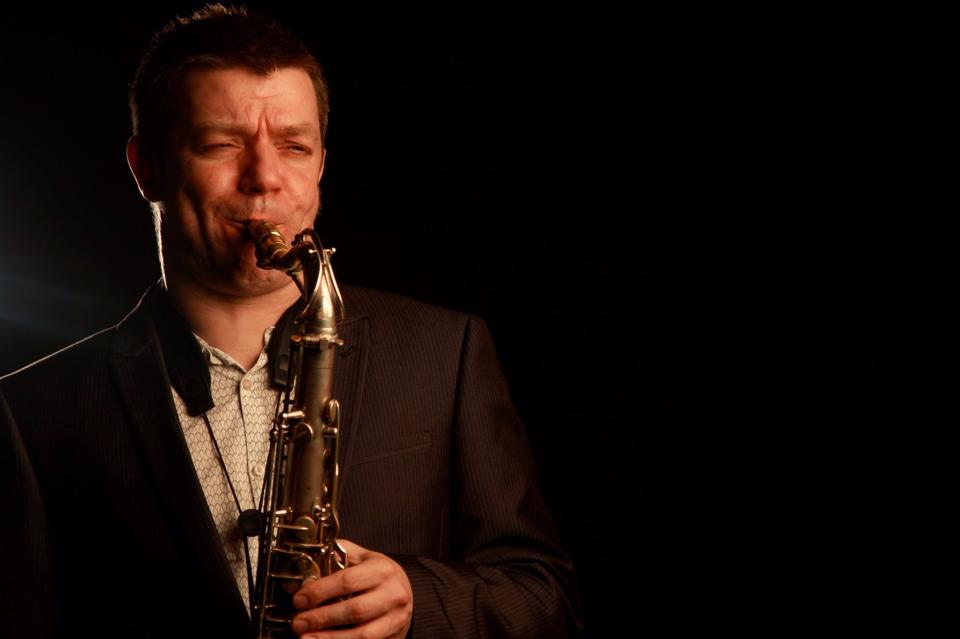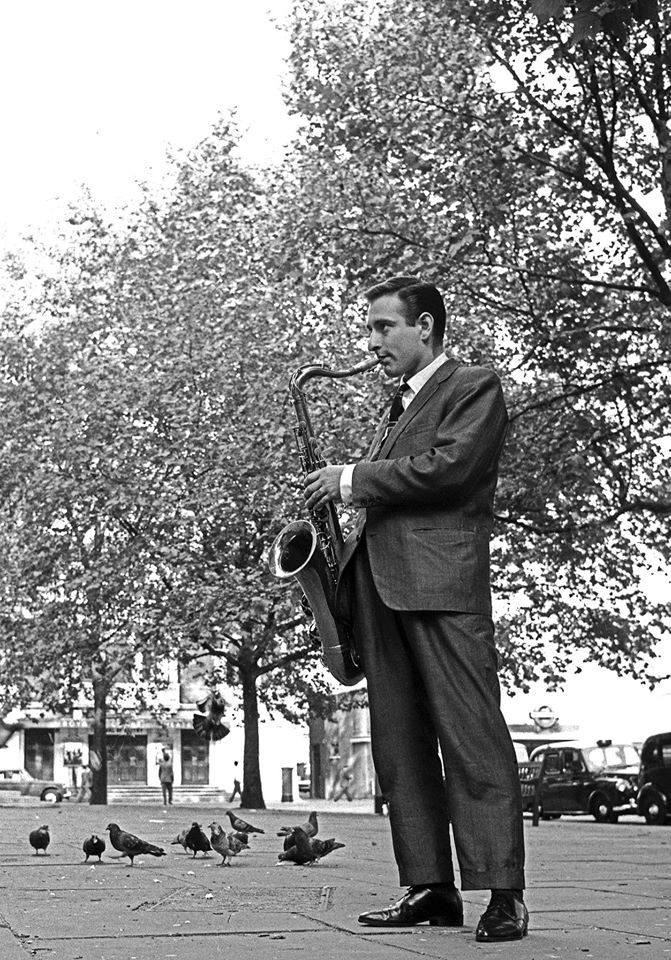Ian Price: A Tribute by Eddie Myer

This magazine’s April Issue 17 carried interviews with two remarkable saxophonists. Tony Kofi’s name will be familiar to jazz fans across Europe and America, and can be found in his biography printed alongside those of Sam Rivers, Andrew Hill and Ornette Coleman. Ian Price’s name is less well known, but eminently deserves a position in this elevated company. In his interview he speaks with well-earned confidence of the imminent recording of his debut album as a leader, but sadly this plan was never to be realised, as a then-undiagnosed illness cut short first his career and then his life with unexpected swiftness, leaving his family, his many friends and fans shocked, saddened and bereft.
Ian’s passing leaves a void at the heart of the Brighton Jazz scene, and the respect and love he was accorded by his fellow musicians can be seen in the impressive line-up of players who contributed their talents in the two days of music at the Verdict, organised by his colleague and friend John Donaldson. Intended as a fundraiser for Ian’s treatment, the event became a memorial, so quick was his decline. Ian had moved to Brighton 19 years ago when he was 26, having grown up in the Shropshire town of Whitchurch. It was a musical household; his mother and father and all of his four siblings played or sang, and his mother taught them all piano. Further piano lessons with a Miss Fletcher followed, as did a stint as a choirboy in the local church, and this was the extent of Ian’s formal training. In his interview in this magazine, he recounts how a chance encounter with a Sade tune that featured a few bars of saxophone over a walking bass line (he didn’t specify which one; possibly “Your Love Is King”) first alerted him to the possibilities of jazz. His parents lent him the money for a saxophone, which he taught himself to play, and before long he was performing in a variety of bands around the local area, often with his longtime friend, pianist Julian Bendall. A press cutting records the pair making an appearance with Roy Wood on the Wogan Show, with the headline “Rock man Ian Set For The Big Time”, which in later years must have appealed immensely to his wry sense of humour.
Ian and Julian both moved to Brighton at the same time and quickly established themselves on the local circuit, playing and recording together as Overstreet and in Julian’s Bah Samba project. At the time, the jazz scene in Brighton was smaller than it is now; Ian’s unswerving dedication and the energy and commitment of his playing soon gained attention, and he formed many friendships and working relationships with those players whose commitment matched his own, which lasted throughout his life. In 1998 pianist Terry Seabrook invited him to join his afro-cuban jazz band Cubana Bop, and Ian became the popular outfit’s longest serving member – he only depped out three gigs in fifteen years! This was the beginning of a solid and long-lasting musical comradeship that also resulted in Ian playing as a featured soloist alongside Alan Barnes, Graeme Flowers, Matt Wates and Martin Shaw in Terry’s Milestones band, notably at the Swanage and Brecon jazz festivals, as well as performing on his live soundtrack to the Buster Keaton movie Young Sherlock. Terry remembers his enthusiasm, commitment and zest for the music, as well as his incredibly supportive attitude. A chance meeting at a ‘dep’ gig led to a significant association with another respected pianist, John Donaldson, and the role of frontline horn in his Nearer Awakening album of the music of Bheki Mseleku. This project also toured extensively, and at the Brecon Jazz Festival the line-up was augmented to a sextet that featured Ian alongside trumpeter Quentin Collins and legendary British alto Pete King. Ian’s interest in exploring Afro-Latin rhythms led to him traveling to Brazil and playing and touring with Pedro Martin’s Bazeado, with whom he recorded the album Requebra Nega for Mr Bongo records. In between, Ian lived the typical life of a jobbing musician, playing and recording with innumerable projects in Brighton and the South-East. Such was the impact of his playing, any bandleader who heard him would rush to sign him up; and though financial necessity sometimes drove him to accept musical situations that weren’t always completely congenial to him, he would always demonstrate total commitment in his performances.
Nowadays jazz can be studied to degree level and beyond in a number of respected institutions, and standards are correspondingly high. Ian was remarkable in being entirely self-taught; not only on his chosen instrument, the tenor saxophone, and his other ‘doubles’ on flute, alto and bass clarinet and alto sax, but also in the intricacies of modern jazz harmony and composition. By his sheer self-motivated dedication, he equalled and exceeded the current benchmarks for the contemporary jazz musician spending countless hours alone in his studio transcribing from the greats. Terry remembers the accuracy with which he tackled the Coltrane sound and approach in the Milestones project, while still stamping the material with the mark of his own personality. For Ian, jazz music was the most important thing there was; a journey he was determined to pursue as far as he could with every resource available to him. Somehow he also found time to be a warm, funny and honest friend and bandmate, with a keen sense of humour, especially concerning the many absurdities encountered in the musician’s life. His musical interests were wide enough to include the chorinhos of Brazil and the son montunos of Cuba, George Levy’s classical wind quartet and Django Reinhardt-style gypsy swing, while the vagaries of his career included appearances in contexts as diverse as Roy Ayers’ touring band and the latin-flavoured reworking of the Blind Date title music, but the over-riding passion of his life, the journey of discovery on which the Sade track’s jazzy interlude had sent him, was the acoustic jazz tradition, from Coleman Hawkins through Coltrane and Joe Henderson to the swinging contemporary modernism of Chris Potter, Jimmy Greene, Joel Frahm and Seamus Blake. His sound on tenor, alternatively light and lyrical and hoarsely impassioned, harmonically sophisticated and tonally ‘centred’, was a work in endless progress, but always transcended his influences to be recognisable as his own. Despite being loud and fast when appropriate,and occasionally prolix, his playing was free of clichéd licks and obvious showboating, as it was from the soulless slickness sometimes associated with schooled jazz players, and any slight hesitancy or awkwardness only added to the sense of an utterly genuine, truly original voice – an impression borne out by the few of his remarkable original compositions he allowed to be performed in public.
Musician’s careers go up and down, but recently Ian had been writing his own material, enjoying popular regular gigs, and recording as a sideman, more than ever before, and it seemed as if a new chapter was about to start. A bigger stage surely awaited him. We’re thankful for the legacy he left behind, in memories, in recordings, in his hilariously irreverent online comments, and in the example and inspiration he showed in his unfaltering devotion to the music he loved so much.
Eddie Myer, 2014
The Sussex Jazz Mag interviewed Ian Price in issue 17 which you can read here.
This article is part of a tribute to Ian Price in issue 27 of The Sussex Jazz Mag, available here.
For more on Ian Price and his music visit www.ianpricemusic.co.uk



